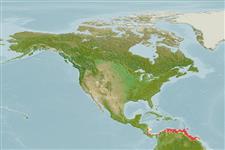Common names from other countries
>
Acropomatiformes (Oceanic basses) >
Synagropidae (Splitfin ocean-basses)
Etymology: Caraibops: Name from 'caraib', a collective name for the Indian tribes formerly inhabiting the Caribbean basin, combined with the ending -ops for the similar sounding to the related genus Parascombrops..
Environment: milieu / climate zone / depth range / distribution range
Ecologia
marinhas batidemersal; intervalo de profundidade 36 - 550 m (Ref. 9626). Deep-water; 13°N - 6°N
Western Atlantic: from NE Gulf fof Mexico to Suriname.
Tamanho / Peso / Idade
Maturity: Lm ? range ? - ? cm
Max length : 11.5 cm TL macho/indeterminado; (Ref. 9626)
Espinhos dorsais (total) : 8 - 9; Raios dorsais (total) : 10; Espinhos anais: 3; Raios anais : 8 - 9; Vértebras: 25. This species is distinguished by having an elongate body, slender head; clearly separated first and second dorsal fins; pelvic spines with anterior edge distinctly serrated; anterior edge of second spine of first dorsal and anal fin smooth; A III; D1 XIII; 46-51 pored lateral line scales; weakly serrated posterior margin of preoperculum; both jaws with a single row of teeth; canines long, sharp, well separated; upper jaw with 3-4 prominent fanglike teeth anterior to the vomer and without large canines on premaxillary; lower jaw with 2 small canines at front, followed by 3-5 large canines; 2 canines on vomer; villiform teeth on palatine (Ref. 80062).
Encountered near the surface at night.
Ciclo de vida ou comportamento de acasalamento
Maturities | Reprodução | Spawnings | Egg(s) | Fecundities | Larvas
Mejía, L.S., A. Acero P., A. Roa and L. Saavedra, 2001. Review of the fishes of the genus Synagrops from the tropical Western Atlantic (Perciformes: Acropomatidae). Caribb. J. Sci. 37(3-4):202-209. (Ref. 43234)
Status na Lista Vermelha da UICN (Ref. 130435)
CITES (Ref. 128078)
Not Evaluated
Ameaça para os humanos
Harmless
Uso pelos humanos
Ferramentas
Relatórios especiais
Baixar XML
Fontes da internet
Estimates based on models
Preferred temperature (Ref.
115969): 13.1 - 22.4, mean 18 (based on 26 cells).
Índice de diversidade filogenética (Ref.
82804): PD
50 = 1.0000 [Uniqueness, from 0.5 = low to 2.0 = high].
Bayesian length-weight: a=0.00955 (0.00424 - 0.02152), b=3.02 (2.82 - 3.22), in cm Total Length, based on LWR estimates for this (Sub)family-body shape (Ref.
93245).
Nível Trófico (Ref.
69278): 3.4 ±0.5 se; based on size and trophs of closest relatives
Fishing Vulnerability (Ref.
59153): Low vulnerability (10 of 100).
